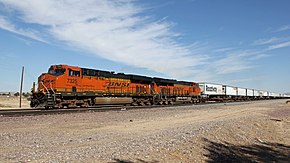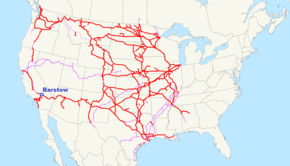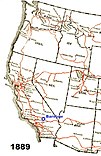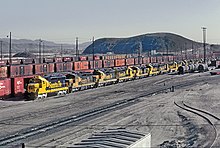Barstow Yard
| Barstow Yard | |
|---|---|
|
Aerial view of Barstow with the railway tracks along the mostly dry river bed of the Mojave River |
|
| Data | |
| Operating point type | Marshalling yard |
| Design | Through station |
| opening | 1913 |
| location | |
| Place / district | Barstow |
| State | California |
| Country | United States |
| Coordinates | 34 ° 53 '35 " N , 117 ° 4' 29" W |
| List of train stations in the United States | |
The Barstow Yard is a marshalling yard of the BNSF Railway in Barstow , California . With 48 directional tracks and a total area of 240 hectares, it is the second largest marshalling yard west of the Rocky Mountains after the JR Davis Yard. Today almost all freight traffic to and from Southern California runs through it.
Its beginnings go back to the construction of a southern transcontinental rail link through the Atchison, Topeka and Santa Fe Railway (AT&SF). This required the late 19th century the Mojave Desert to be crossed in which a for traffic from the at the site of the present Barstow Midwest major turn-off to San Francisco in the north as well as Los Angeles and San Diego was built in the southwest. AT&SF expanded the railway facilities in the early 1970s to form a large flat station that extends above the city for almost eight kilometers along the Mojave River . In 1995 the AT&SF merged with the Burlington Northern Railroad (BN) to form the Burlington Northern Santa Fe Railway (BNSF Railway). The company now operates the transcontinental connection under the name Southern Transcon and in 2019 employed around 1,000 people at the marshalling yard in Barstow.
story
Railroad networks in Southern California and the city of Barstow from the 1870s
By 1867, the Southern Pacific Railroad (SP) had completed the western portion of the first transcontinental railroad link between San Francisco , Northern California and Omaha , Nebraska , and expanded into Southern California in the 1870s. It expanded its network from Los Angeles to Yuma on the Colorado River in Arizona . They also built a stretch from Mojave through the desert of the same name to Needles , which is also about 200 kilometers north of Yuma on the Colorado. The Atlantic and Pacific Railroad planned between Missouri and California was connected here, the western section of which ran eastwards to Isleta in New Mexico . At the same time, the California Southern Railroad created a line from San Diego in the south via San Bernardino to the line of the SP near today's Barstow , about 100 kilometers east of Mojave. The junction was then still called Waterman Junction after the later governor of California Robert Waterman , who had a ranch here and operated several silver mines in the region . During the second phase of the Great Depression from 1873-1896 , the western part of the never-completed Atlantic and Pacific - between Needles and Isleta - was reorganized as a subsidiary of the Atchison, Topeka and Santa Fe Railway (AT&SF), which made its network westward via Isleta to Needles advanced; the eastern part became part of the St. Louis - San Francisco Railway . AT&SF also acquired the section through the Mojave Desert from the SP and finally reached the west coast through its subsidiary California Southern. The Waterman Junction was named in 1886 by the president of the AT & SF William Barstow Strong in Barstow to.

The AT&SF was able to expand its original network from Kansas ( Atchison and Topeka ) to New Mexico ( Albuquerque and Santa Fe ) to the Pacific coast at the end of the 19th century , which stretched in the east from 1888 to Chicago in Illinois . It created another transcontinental railroad connection in the south of the USA after the Sunset Route of the SP, completed in 1883 , which ran further south from Yuma via El Paso to New Orleans . Due to its location at the junction of the routes to San Francisco in the north and to Los Angeles and San Diego in the southwest, Barstow was next to Sacramento one of the most important railway hubs in California at the beginning of the 20th century . After the station building was destroyed by a fire at the end of 1909, AT&SF also built a large depot with a roundhouse for 25 steam locomotives and expanded the track system along the Mojave River into a large marshalling and freight yard. In Northern California, the SP built the Roseville Yard about 25 kilometers northeast of Sacramento from 1906 , which is still the largest marshalling yard in California today.
Construction of the Casa del Desierto for the Fred Harvey Company in 1913
During the Civil War (1861-1865), the restaurant owner Fred Harvey , who originally emigrated from England in 1850, had to give up his restaurant in St. Louis and subsequently worked for various railroad companies. As a result, he traveled a lot along the new routes in the USA and was appalled by the poor quality of the food on offer. He recognized the increasing need for proper passenger care and in 1876 took over the first restaurant in the AT&SF station building in Topeka and two years later the hotel and restaurant of the railway company in Florence (Kansas) . Harvey attached particular importance to the high quality of the service and the food on offer and was so successful with it that in 1889 he received an exclusive contract from AT&SF to operate all hotels and restaurants along the AT&SF routes west of the Missouri River . The railway company provided the premises and took over the transport of all goods necessary for the operation and Harvey was responsible for the equipment, the food, the staff and the maintenance. The Fred Harvey Company became the first restaurant chain in the USA. In 1893 she also took over the business in Barstow and opened a first Harvey House here in the station buildings .
In the course of the rebuilding of the burned down station building, a new restaurant and hotel complex, the Casa del Desierto (dt. 'House of the Desert' or 'Desert House'), which was designed by the architect Francis W. Wilson in a mixture of Spanish Renaissance Architecture and neoclassicism and has been preserved in almost its original state to this day; the interior design of the Harvey houses built at that time came from Mary Colter . With the decline in passenger traffic, AT&SF gave up the building in the early 1970s. It was listed as a Historic Monument in 1975 by listing it on the National Register of Historic Places (# 75000458). The city of Barstow acquired the building in 1990 and renovated it after being damaged by an earthquake in 1992. It now serves mainly as a museum and Amtrak station.
Casa del Desierto between the Mojave River and the AT&SF railway systems around 1924
Recording from HAER 1994 (View from the city of Barstow to north)
The building now used as a museum and Amtrak station in 2012
Expansion from the 1930s and modernization in the 1970s
With the advent of diesel locomotives in the 1930s, AT&SF built a new maintenance hangar for this type in Barstow, which, in contrast to the old roundhouse, had several parallel butt tracks . In the 1940s, half of all AT&SF diesel locomotives were serviced here, including the EMD E , FT and F7 series , which were used for the Super Chief passenger train, among other things . This operated from 1937 to 1971 via Barstow between Chicago and Los Angeles , the connection is now operated by Amtrak as Southwest Chief .
The Barstow Yard as it is today was built in the early 1970s. AT&SF invested 50 million US dollars in the construction of an automated flat train station with a waste mountain. The new marshalling yard was built to the west of the old tracks, which today form the eastern part of the marshalling yard as an additional subordinate group. The depot was moved from the east side to the end of the west side; At the old location, some stub tracks have remained. In 1995 AT&SF merged with the Burlington Northern Railroad (BN) to form the Burlington Northern Santa Fe Railway ( BNSF Railway ), which in 2019 employed around 1000 people on the facilities. The Barstow Yard is next to the Argentine Yard in the metropolitan area of Kansas City (formerly AT&SF) and the Northtown Yard in Minneapolis (formerly BN) one of the largest marshalling yards in the network of the BNSF and after the JR Davis Yard (formerly Roseville Yard) of the Union Pacific Railroad the second largest in California.
description
The Barstow Yard extends above the town of Barstow for almost eight kilometers along the Mojave River and covers an area of about 240 hectares . Following the flow of traffic, the track systems of the flat station are divided from west to east into the following track groups: The arriving freight trains are directed into the entry group (approx. 10 tracks) in the west. The mainline locomotives (line haul) are replaced here by shunting locomotives (switcher) , which move the trains to the drainage hill and push the freight wagons into the eastward direction harp (48 tracks) in the center . Here these are put together to form new train groups, which are later transported to the subordinate group (approx. 10 tracks) in the eastern part, whose tracks are used to change direction to the exit group (approx. 15 tracks) above the direction harp ( pull-out tracks ). Before the exit, mainline locomotives take over the final trains, whereby several locomotives are usually combined into so-called consists .
At the end of the west side there is the depot with a maintenance hall for diesel locomotives with six continuous tracks and further systems for refueling and cleaning as well as a turning loop . There is also a maintenance hall for freight cars (three continuous tracks) and several sidings for locomotives between the discharge hill and the exit group. In the north, several busy bypass tracks border the area (BNSF Cajon and Mojave subdivisions) , which are also used by Amtrak and the Union Pacific.
Barstow
 on the road network of Southern California northeast of the Greater Los Angeles Area
on the road network of Southern California northeast of the Greater Los Angeles Area
Location and extent of Barstow Yard . Right below the town of Barstow below the east side, above the Harvey House. On the left the larger western part along the Mojave River (above).
In 2018, BNSF invested USD 27 million in the construction of a container terminal on the south side of the marshalling yard. Across from the depot, two new one-kilometer loading tracks with an attached parking space for over 600 semi-trailers were put into operation in 2019 . With over five million freight containers per year, the BNSF has the largest market share in intermodal freight transport among the Class I railroad companies and, with the terminal in Barstow, wants to relieve other terminals in Southern California along the Southern Transcon Corridor, such as the Hobart Yard in Los Angeles, which is the BNSF's largest container terminal with over a million containers moved each year. Barstow is located on the road network of California at the junction of Interstate 15 (north-south) with Interstate 40 and State Route 58 (east-west).
Air pollution from diesel locomotives

BNSF 7325: SD40-2 from 1999 (mod.SD40 from 1967, Tier 1)
BNSF 6897: GE ES44C4 from 2011 ( Tier 2)
In 2005, the California Air Resources Board (CARB) signed an agreement with the two largest railroad companies operating in California, BNSF and UP, to reduce fine dust pollution at marshalling yards in the state by about 20% (Statewide Railyard Agreement) . Part of the agreement was the implementation of health risk assessments for the 17 largest marshalling yards. In 2006, according to the CARB study, more than 150,000 diesel locomotives passed Barstow Yard , of which only 54,000 stopped on the site or were used to operate the marshalling yard. As a result, the Barstow Yard had the highest particulate matter pollution of all Californian marshalling yards in 2006 with 28 tons, which was even higher than that of the larger JR Davis Yard of the UP (25 tons) due to the immense through traffic . With the tightening of the state's air pollution control regulations in California, the BNSF was forced to renew its fleet of diesel locomotives, and in 2012 84 percent of the more than 6,000 locomotives met the environmental protection agency Tier 0-3 emission standards . Funded by the CARB and in cooperation with GE Transportation , BNSF will, among other things on a route between Barstow and Stockton from 2020 the use of battery - electric locomotives study in combination with conventional diesel locomotives.
See also
- List of marshalling yards
- BNSF Railway marshalling yards: Argentine Yard , Corwith Yard , Galesburg Yard , Northtown Yard
Web links
- BNSF in California. ( CA Operating Division Map )
- Images of Barstow Yard from 1975. ArizonaLorne
- BNSF Barstow Yard Tower Tour HD. Film documentation of the marshalling yard on YouTube.
Individual evidence
- ^ Richard V. Dodge: Perris and its Railroad. California Southern Railroad History, San Diego Railroad Museum, accessed July 2, 2019.
- ^ Robert Waterman 1887-1891. Governors of California, California State Library, accessed July 2, 2019.
- ↑ Christine Toppen Berg, Donald Atkinson: Barstow. Arcadia Publishing, 2015, ISBN 978-1-4396-5429-3 , Chapter One (eBook without page numbers).
- ^ Walter Feller: The Southern Pacific and later Santa Fe transcontinental route. digital-desert.com, accessed on July 2, 2019.
- ^ History. City of Barstow, accessed July 2, 2019.
- ^ Rudolph L. Daniels: Trains Across the Continent: North American Railroad History. 2nd Edition, Indiana University Press, 2000, ISBN 978-0-253-21411-9 , pp. 58-60.
- ^ Santa Fe Yard Improvements at Barstow, California. In: Engineering Record, Building Record and Sanitary Engineer. Vol. 66, No. 21, 1912, p. 467.
- ^ Arnold Berke: Mary Colter: Architect of the Southwest. Princeton Architectural Press, 2002, ISBN 978-1-56898-295-3 , pp. 39-45.
- ↑ Michael Bellomy: Harvey House: Casa del Desierto. National Register of Historic Places Inventory - Nomination Form, National Park Service, 1975.
- ↑ Our History. Route 66 "Mother Road" Museum, accessed July 3, 2019.
- ^ Shops in Desert Keeps Diesel Giants Rolling. In: Popular Science. Vol. 151, No. 6, December 1947, p. 148 f. ( Limited preview in the Google book search).
- ^ Diesel Locomotives. In: Life. Vol. 22, No. 20, May 19, 1947, pp. 61–67 ( limited preview in Google book search).
- ^ A b Michael Rhodes: North American Railyards. Voyageur Press, 2014, ISBN 978-0-76034-609-9 , pp. 39-41.
- ^ A b John Beyer: BNSF nears completion of Barstow facility. ( Memento of April 14, 2019 on the Internet Archive ) Daily Press, Victorville, April 12, 2019, accessed July 3, 2019.
- ^ Eugene Yang, Stephen Cutts, Hector Castaneda: Health Risk Assessment for the BNSF Railway Barstow Railyard. California Air Resources Board, June 9, 2008, pp. 31-35.
- ↑ Intermodal: How BNSF Delivers More. BNSF Railway, accessed December 11, 2019.
- ↑ Regional Rail Simulation Findings: Technical Appendix. Southern California Association of Governments, Jan. 2011, p. 32, accessed December 11, 2019.
- ^ Statewide Railyard Agreement: Particulate Emissions Reduction Program at California Rail Yards. California Air Resources Board, June 2005, accessed December 12, 2019.
- ^ Eugene Yang, Stephen Cutts, Hector Castaneda: Health Risk Assessment for the BNSF Railway Barstow Railyard. California Air Resources Board, June 9, 2008, pp. 6-13.
- ^ Harry Stevens: Union Pacific Delivers Cargo Load of Innovation to Meet EPA Emissions Standards. TriplePundit, December 18, 2012. Accessed July 4, 2019.
- ↑ Stuart Chirls: BNSF awarded $ 22.6M grant for California clean tech yard program. Railway Age, October 11, 2018, accessed July 4, 2019.
- ↑ Evan Hoopfer: BNSF progresses on battery-electric locomotive. Dallas Business Journal, September 12, 2019, accessed December 9, 2019.












